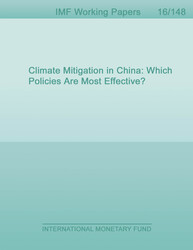
Climate Mitigation in China : Which Policies Are Most Effective?
For the 2015 Paris Agreement on climate change, China pledged to reduce the carbon dioxide (CO2) intensity of GDP by 60–65 percent below 2005 levels by 2030. This paper develops a practical spreadsheet tool for evaluating a wide range of national level fiscal and regulatory policy options for reducing CO2 emissions in China in terms of their impacts on emissions, revenue, premature deaths from local air pollution, household and industry groups, and overall economic welfare. By far, carbon and coal taxes are the most effective policies for meeting environmental and fiscal objectives as they comprehensively cover emissions and have the largest tax base.
Publication date: July 2016
ISBN: 9781475574524
$18.00
Add to Cart by clicking price of the language and format you'd like to purchase
Available Languages and Formats
| English |
Prices in red indicate formats that are not yet available but are forthcoming.
Topics covered in this book
This title contains information about the following subjects.
Click on a subject if you would like to see other titles with the same subjects.
Economics- Macroeconomics , Economics- Macroeconomics , Economics / General , Economics / General , International - Economics , International - Economics , Paris Agreement , carbon tax , China , air pollution , coal tax , emissions trading , incidence , welfare effects
Also of interest
Summary
Copyright © 2010 - 2025
Powered by:
AIDC



